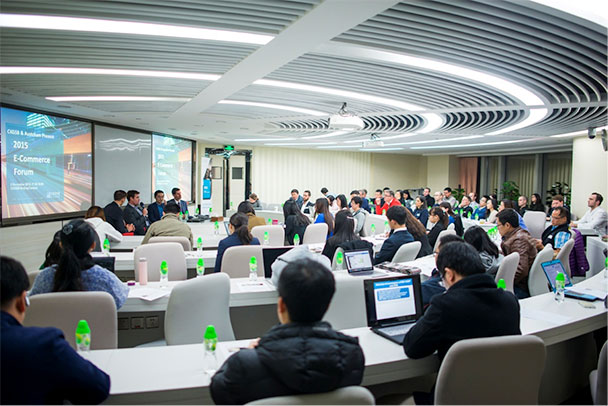Today, Alibaba made close to $4 billion in sales within the first hour of Singles’ Day in China, the world’s biggest online shopping event. The figure is nearly double the $2 billion spent in the same time of the retail giant’s sales last year. In fact, Alibaba’s sales reached $9.3 billion on Singles’ Day in 2014, roughly double what was sold on Cyber Monday following Thanksgiving in the US.
China’s e-commerce market is certainly growing quickly, due to rapid growth in mobile phone ownership and a large number of consumers living in small cities with limited selection of goods on sale in shops, among other reasons. However, while China’s e-commerce market is promising, it also presents a number of challenges that, if not addressed, could swallow a company’s investments. To assist business leaders and professionals—especially those from foreign small and medium-sized enterprises (SMEs)—understand the opportunities and challenges ahead in China’s e-commerce, Cheung Kong Graduate School of Business (CKGSB) and the Australian Chamber of Commerce (Austcham) jointly organized the 2015 E-Commerce Forum at CKGSB’s Beijing Campus on November 5.

The Forum convened experts from different sectors, including online payments, digital marketing and consulting. The forum’s moderator—Timothy Coghlan, Associate Director of Luxury Retail with Savills—walked the audience through the entire process an SME must take to effectively leverage e-commerce platforms in China, from choosing a suitable platform and finding a partner to marketing and logistics.

Timothy Coghlan, Associate Director of Luxury Retail with Savills
How to find your spot among China’s e-commerce platforms
Pablo Recio Gracia, Manager Director of Eibens—a consulting company established in China in 2005 that facilitates SMEs from abroad to access China, especially the Food & Beverage market—advised small companies to identify a platform like JD.com that can buy the product from you. Gracia added, “JD.com is a good platform for companies to sell products on once you have a Chinese-language website and a WeChat account, because JD has invested in WeChat, so you automatically get a shop on WeChat, too.” Otherwise, there are other platforms available, such as Tmall, which commands a huge audience, but a firm on there must consider how to attract its own customers given the vast size of such platforms.
For nations that wish to sell their goods via e-commerce platforms in China, Gracia emphasized that they would first need authorization for their respective embassies in China to ensure their goods are authentically sourced from those countries. Additionally, he advised countries to offer a diverse range of products, since that will garner greater traffic and attention.

Pablo Recio Gracia, Manager Director of Eibens
For companies that may not have sufficient funds to initially invest in shops on e-commerce platforms—an investment that may range between half a million to 1 million RMB at the least—Gracia offered practical advice to business owners: “Find a partner with complementary products to yours and set up a shop together.”
How to build a brand
To attract sufficient customers to your online store or products, Allen Qu, CEO and China Founder of Netconcepts, advised companies to actively put their firms in front of people via their website and WeChat accounts among other channels, saying a firm can push its message out through hard-selling and/or soft-selling. The latter, which includes digital marketing, is especially useful because it can be low-cost and effective. Qu recommends for firms to first “optimize your own website, especially for mobile, as 70% of online searches on Baidu, for instance, are conducted on mobile devices.” At the least, a firm must try to own the key words associated with its products or differentiators. Secondly, Qu urged companies to manage their online reputation, for example, through recommendation and evaluation sites.

Allen Qu, CEO and China Founder of Netconcepts
Gracia emphasized the need for O2O marketing. Ideally, a company should combine online commerce and marketing with offline efforts, such as working with consulting companies to promote its products at trade fairs. Gracia raised the example of cross-border commerce, saying that it adds great credibility to a company that wishes to sell offline via distributors if it is already selling online.
Qu echoed Gracia’s advice on O2O. In addition to online marketing, he said a company should invest in brand exposure through offline events and partnerships. Qu suggested companies create industry awards that allow them to both market their brand while setting standards.
How to purchase – payments and logistics
“No brand can handle their end-to-end e-commerce on their own,” said Coghlan at the forum, when emphasizing the importance of companies like SmartTrans that handle payments and logistics. Bryan Carr, CEO of SmartTrans, had a few recommendations for SMEs on this issue. “Companies need to make it as easy as possible for customers to purchase on their online store or platform.” In fact, ideally payment should be done through channels that customers are already familiar with or even have credit in. Most importantly, it should be a channel that they trust.

Bryan Carr, CEO of SmartTrans
Cross-Border E-Commerce
For SMEs that want to test the Chinese e-commerce market, cross-border transactions are a better way to do so, rather than sending large containers of goods to China and making significant investments in the beginning, said Carr.
Cross-border e-commerce may be especially tricky with F&B products, especially perishable goods. On this, Gracia offered practical advice to SMEs. “Chinese customers in the eight major cities of China expect to receive their goods in less than 24 hours, while in other cities they expect to do so within 3 to 5 days,” explained Gracia. “Hence, for cross-border F&B commerce, companies must place their goods in either Hong Kong or in the Shanghai Free Trade Zone to be able to deliver in time, but the latter can be quite expensive.”

A Promising Market
Even though China’s economy is heading for its slowest growth in nearly a quarter of a century, the country’s e-commerce market is booming at a rate faster than ever before. This shows the potential in China’s domestic consumption and signals to domestic and foreign firms the opportunities available. However, to succeed in this market, firms must understand the Chinese economy and consumers, and overcome hurdles in setting up online shops, handling payments and logistics, and marketing their brand or products. The advice that the speakers at the E-Commerce Forum offered is invaluable to firms, especially SMEs, which seek to enter this market.